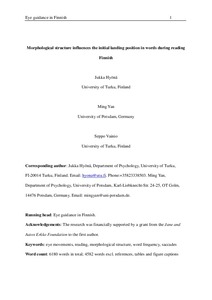Morphological structure influences the initial landing position in words during reading Finnish
Jukka Hyönä; Ming Yan; Seppo Vainio
https://urn.fi/URN:NBN:fi-fe2021042718724
Tiivistelmä
The preferred viewing location in words [Rayner, K. (1979). Eye guidance in reading: Fixation locations within words. Perception, 8, 21–30] during reading is near the word centre. Parafoveal word length information is utilized to guide the eyes toward it. A recent study by Yan and colleagues [Yan, M., Zhou, W., Shu, H., Yusupu, R., Miao, D., Krügel, A., & Kliegl, R. (2014). Eye movements guided by morphological structure: Evidence from the Uighur language. Cognition, 132, 181–215] demonstrated that the word’s morphological structure may also be used in saccadic targeting. The study was conducted in a morphologically rich language, Uighur. The present study aimed at replicating their main findings in another morphologically rich language, Finnish. Similarly to Yan et al., it was found that the initial fixation landed closer to the word beginning for morphologically complex than for monomorphemic words. Word frequency, saccade launch site, and word length were also found to influence the initial landing position. It is concluded that in addition to low-level factors (word length and saccade launch site), also higher level factors related to the word’s morphological structure and frequency may be utilized in saccade programming during reading.
Kokoelmat
- Rinnakkaistallenteet [27094]
